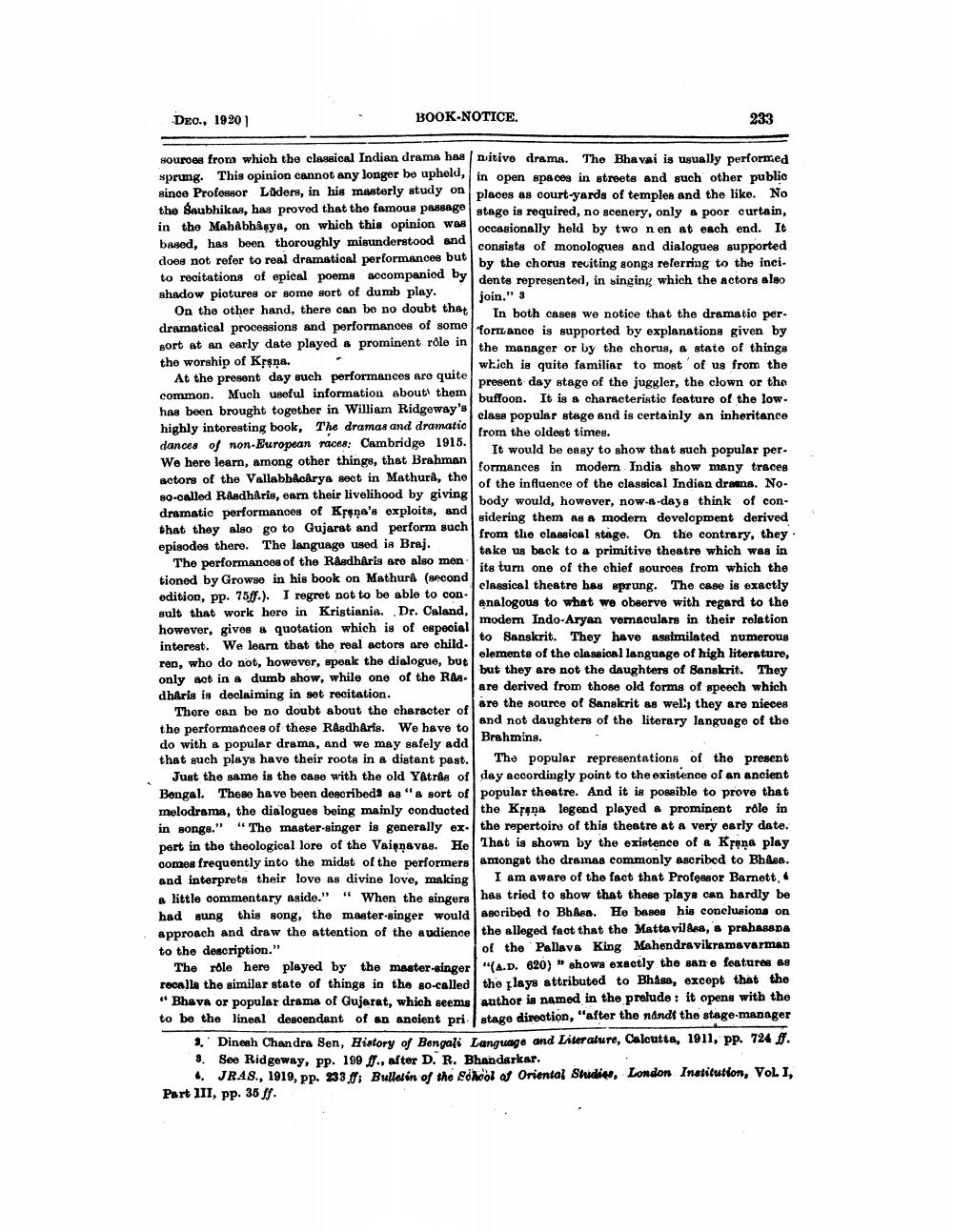________________
DEC., 1920]
BOOK-NOTICE.
sources from which the classical Indian drama has sprung. This opinion cannot any longer be upheld, since Professor Lüders, in his masterly study on the Saubhikas, has proved that the famous passage in the Mahabhagya, on which this opinion was based, has been thoroughly misunderstood and does not refer to real dramatical performances but to recitations of epical poems accompanied by
shadow pictures or some sort of dumb play.
On the other hand, there can be no doubt that dramatical processions and performances of some sort at an early date played a prominent role in the worship of Kṛṣṇa.
At the present day such performances are quite common. Much useful information about them has been brought together in William Ridgeway's highly interesting book, The dramas and dramatic dances of non-European races: Cambridge 1915. We here learn, among other things, that Brahman actors of the Vallabhacarya sect in Mathura, the so-called Rasdhâris, earn their livelihood by giving dramatic performances of Krena's exploits, and that they also go to Gujarat and perform such episodes there. The language used is Braj.
The performances of the Rasdharis are also men tioned by Growse in his book on Mathura (second edition, pp. 75ff.). I regret not to be able to consult that work here in Kristiania. Dr. Caland, however, gives a quotation which is of especial interest. We learn that the real actors are child
ren, who do not, however, speak the dialogue, but only act in a dumb show, while one of the Ras. dharis is declaiming in set recitation.
There can be no doubt about the character of the performances of these Rasdhâris. We have to do with a popular drama, and we may safely add that such plays have their roots in a distant past. Just the same is the case with the old Yatras of Bengal. These have been described as "a sort of melodrama, the dialogues being mainly conducted in songs." "The master-singer is generally expert in the theological lore of the Vaisnavas. He comes frequently into the midst of the performers and interprets their love as divine love, making a little commentary aside." "When the singers had sung this song, the master-singer would approach and draw the attention of the audience to the description."
The role here played by the master-singer recalls the similar state of things in the so-called "Bhava or popular drama of Gujarat, which seems to be the lineal descendant of an ancient pri
233
nitive drama. The Bhavai is usually performed in open spaces in streets and such other public places as court-yards of temples and the like. No stage is required, no scenery, only a poor curtain, occasionally held by two n en at each end. It consists of monologues and dialogues supported by the chorus reciting songs referring to the incidents represented, in singing which the actors also
join." 3
In both cases we notice that the dramatic performance is supported by explanations given by the manager or by the chorus, a state of things which is quite familiar to most of us from the
present day stage of the juggler, the clown or the buffoon. It is a characteristic feature of the lowclass popular stage and is certainly an inheritance
from the oldest times.
It would be easy to show that such popular performances in modern India show many traces of the influence of the classical Indian drama. Nobody would, however, now-a-days think of con
sidering them as a modern development derived
from the classical stage. On the contrary, they take us back to a primitive theatre which was in
its turn one of the chief sources from which the classical theatre has sprung. The case is exactly analogous to what we observe with regard to the modern Indo-Aryan vernaculars in their relation to Sanskrit. They have assimilated numerous
elements of the classical language of high literature, but they are not the daughters of Sanskrit. They are derived from those old forms of speech which are the source of Sanskrit as well; they are nieces and not daughters of the literary language of the Brahmins.
The popular representations of the present day accordingly point to the existence of an ancient popular theatre. And it is possible to prove that the Krsna legend played a prominent role in the repertoire of this theatre at a very early date. That is shown by the existence of a Krena play amongst the dramas commonly ascribed to Bhasa.
I am aware of the fact that Professor Barnett, has tried to show that these plays can hardly be ascribed to Bhasa. He bases his conclusions on the alleged fact that the Matta villea, a prahasana of the Pallava King Mahendravikramavarman "(A.D. 620)" shows exactly the sane features as the plays attributed to Bhasa, except that the author is named in the prelude: it opens with the stage direction, "after the nåndt the stage-manager
1. Dinesh Chandra Sen, History of Bengali Language and Literature, Calcutta, 1911, pp. 724 ff.
3.
See Ridgeway, pp. 199 ff., after D. R. Bhandarkar.
4. JRAS., 1919, pp. 233 ff; Bulletin of the School of Oriental Studies, London Institution, Vol. I, Part III, pp. 35 ff.




